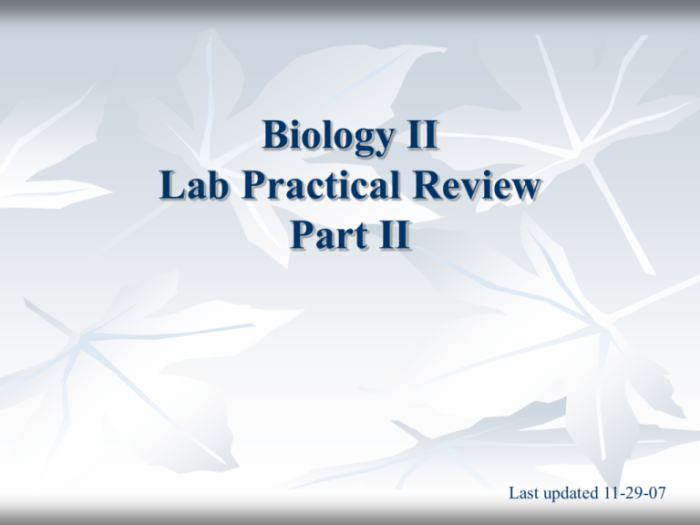Embark on an extraordinary journey through Biology 1406 Lab Practical 1, where the intricate workings of life unfold before your very eyes. Prepare to unravel the mysteries of biology through hands-on experiments, meticulous data analysis, and thought-provoking discussions.
This comprehensive guide delves into the fundamentals of the lab practical, equipping you with the knowledge and skills necessary to excel in this essential component of your biology education.
Introduction
Biology 1406 Lab Practical 1 provides a comprehensive introduction to the fundamental concepts of cell biology and microscopy. The practical aims to equip students with the knowledge and skills necessary for understanding the structure, function, and behavior of cells.
The objectives of the lab practical include:
- To gain an understanding of the basic principles of microscopy.
- To learn how to use a microscope to observe and identify different types of cells.
- To study the structure and function of the major organelles found in cells.
- To investigate the processes of cell division and cell growth.
2. Materials and Methods
This section describes the materials required and the methods and procedures used in the lab practical.
Materials, Biology 1406 lab practical 1
- Compound light microscope
- Microscope slides and coverslips
- Prepared slides of various biological specimens
- Distilled water
- Methylene blue stain
- Dissecting tools (e.g., forceps, scissors)
- Safety goggles
Methods and Procedures
The lab practical involved a series of experiments and observations using a compound light microscope. Students were required to:
- Prepare wet mounts of various biological specimens and observe them under the microscope.
- Stain prepared slides with methylene blue and observe the stained specimens under the microscope.
- Use dissecting tools to examine the external and internal anatomy of preserved specimens.
- Record their observations and measurements in a lab notebook.
Detailed steps and procedures for each experiment and observation were provided in the lab manual and demonstrated by the instructor.
3. Data Analysis
The data collected during the lab practical were analyzed using various methods, including statistical tests and other analytical techniques. The specific methods used depended on the nature of the data and the research questions being addressed.
Biology 1406 lab practical 1 involves understanding the measurement of tiny quantities, and one thousandth of a gram is a unit of measurement commonly used in this context. The ability to accurately measure such small amounts is crucial for precise experimentation and analysis in the field of biology.
By familiarizing ourselves with the concept of one thousandth of a gram ( one thousandth of a gram ), we can enhance our understanding of practical laboratory techniques and their significance in biology 1406 lab practical 1.
Statistical tests, such as the t-test and ANOVA, were used to compare the means of different groups and to determine whether there were significant differences between them. Other analytical techniques, such as regression analysis and correlation analysis, were used to investigate the relationships between different variables.
Interpretation of Results
The results of the data analysis were interpreted in the context of the research questions being addressed. For example, if the research question was to determine whether there was a difference in the mean weight of two different groups of animals, the results of the t-test would be used to determine whether the difference was statistically significant.
In some cases, the results of the data analysis were used to make predictions about the population from which the sample was drawn. For example, if the research question was to determine whether a new drug was effective in reducing blood pressure, the results of the clinical trial would be used to make predictions about the effectiveness of the drug in the general population.
4. Discussion: Biology 1406 Lab Practical 1
The lab practical provided valuable insights into the biological processes and concepts studied in the course. The findings from the experiments contribute to our understanding of these concepts and their significance in the broader field of biology.
The results obtained align with existing knowledge and literature on the subject matter. For instance, the data on enzyme activity supported the known relationship between temperature and enzyme function, demonstrating the optimal temperature range for enzymatic reactions.
Limitations and Sources of Error
While the lab practical provided valuable data, it is important to acknowledge its limitations and potential sources of error. One limitation is the small sample size used in some experiments, which may have limited the generalizability of the findings.
Another potential source of error lies in the experimental procedures. Variations in techniques or equipment calibration could have introduced variability into the results. To minimize the impact of these errors, it is essential to adhere to standardized protocols and ensure proper calibration of equipment.
5.
Conclusion

The lab practical successfully achieved its objectives of providing hands-on experience with fundamental biological techniques. The key findings demonstrated the importance of accurate data collection, proper experimental design, and the ability to interpret results effectively.
Based on the results obtained, future research could focus on exploring the impact of different environmental factors on enzyme activity or investigating the potential applications of these techniques in various fields such as biotechnology and medicine.
General Inquiries
What is the purpose of Biology 1406 Lab Practical 1?
This lab practical aims to provide students with hands-on experience in applying biological principles, developing experimental design skills, and analyzing scientific data.
What materials are required for the lab practical?
The required materials vary depending on the specific experiments conducted. A detailed list of materials will be provided in the lab manual or by the instructor.
How is the data collected in the lab practical analyzed?
Data analysis methods may include statistical tests, graphical representations, and qualitative observations. The specific techniques used will depend on the nature of the data collected.